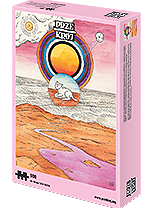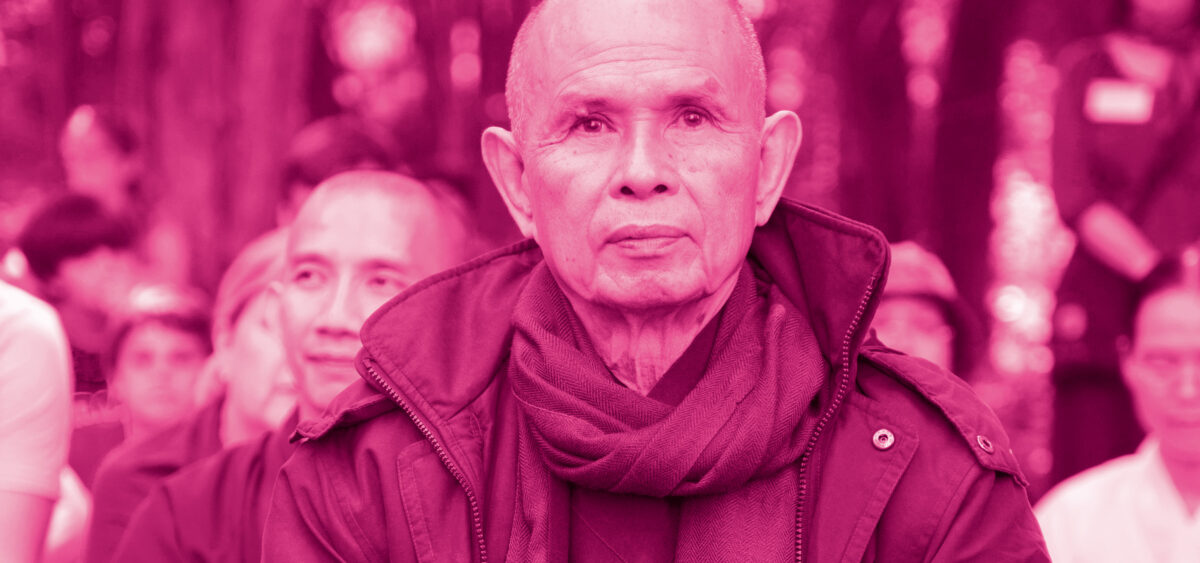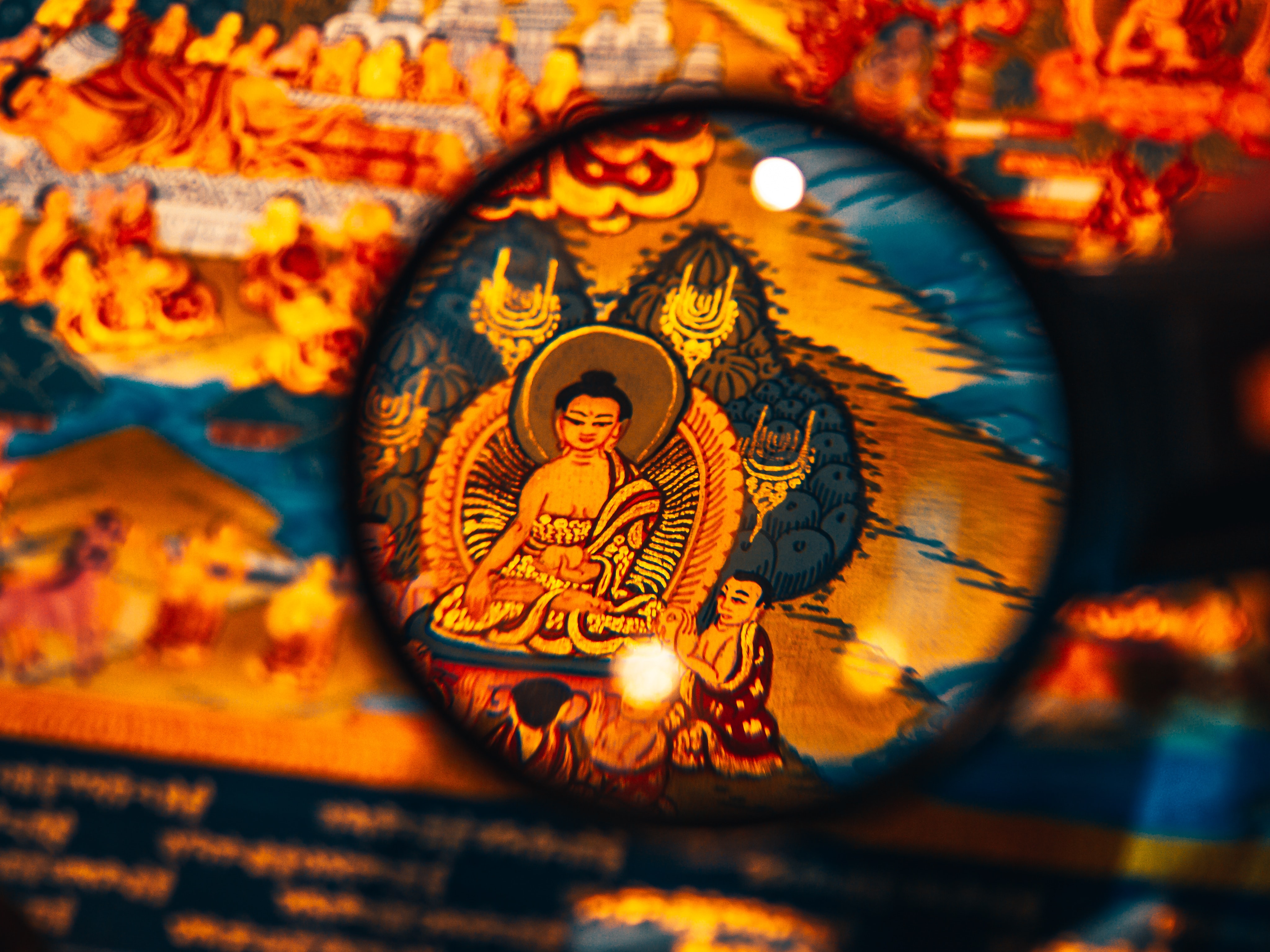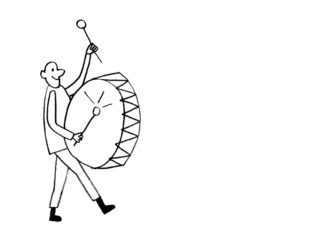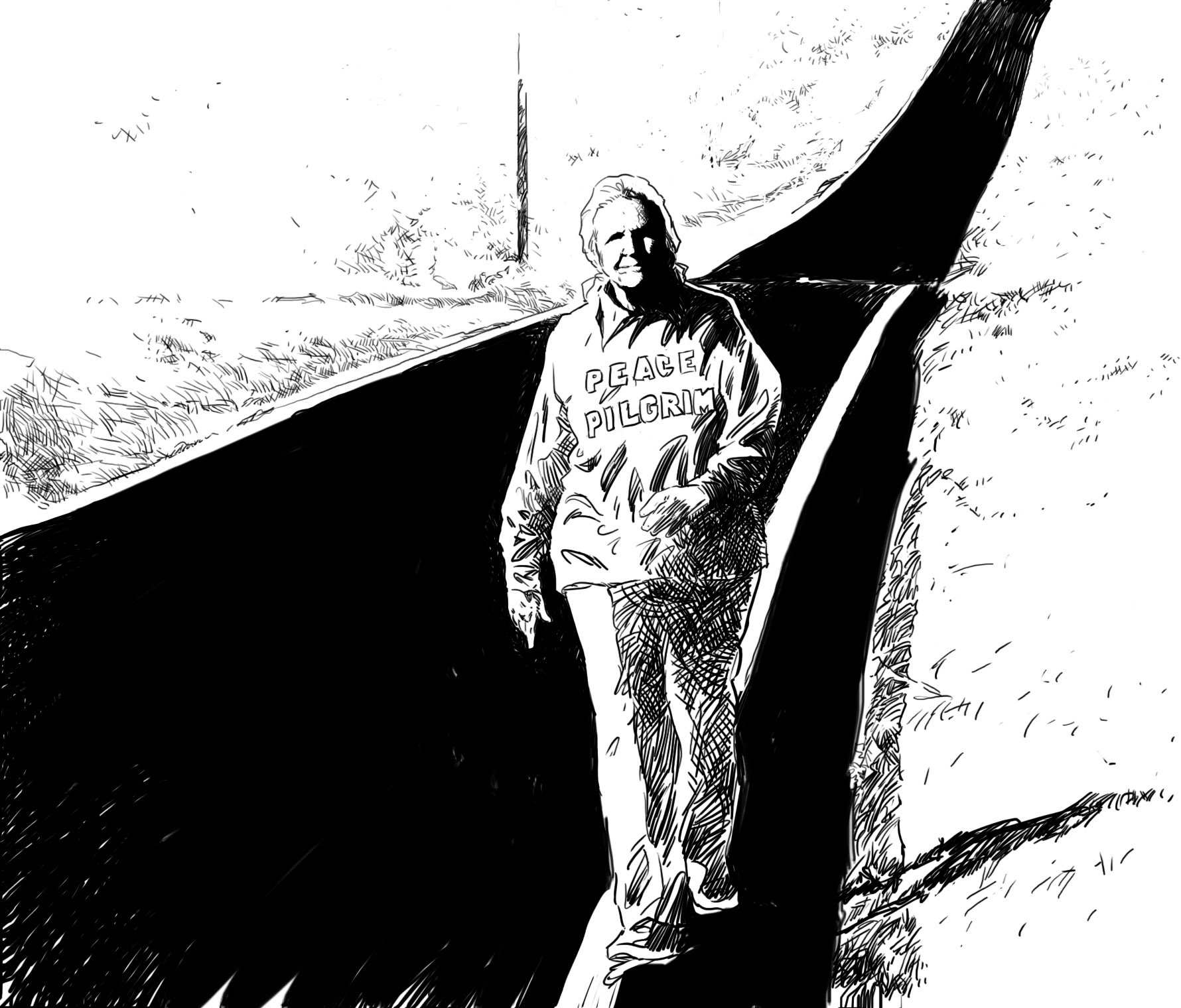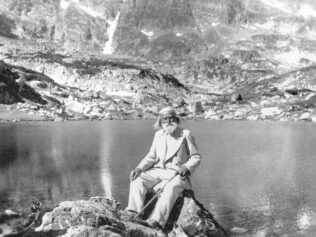
He was a pacifist, who for his work on behalf of world peace was nominated for the Nobel Prize and chased out of his own country. His non-judgemental approach was a gift; he preferred to concentrate on forgiveness and empathy. That’s what he taught all his life. Thích Nhất Hạnh, a Buddhist monk from Vietnam, the spiritual father of mindfulness, died in January. But can somebody who didn’t believe in death really die?
Following the teachings of the Buddha, Nhất Hạnh didn’t identify with the 95-year-old body he inhabited, nor with its limitations. For eight years, he didn’t speak; an extensive cerebral haemorrhage took that possibility from him. A valued teacher and polyglot, who spoke seven languages fluently (including Pali, Sanskrit, French and English), communicating with his surroundings from that point on using gestures, and was confined to a wheelchair. He didn’t flee from suffering; he probed its nature, convinced that only studying pain allows one to feel the fullness of life and true happiness. Long before he started to weaken physically, he taught that life is existence without borders: if we are never born, we never die. He rejected the concept of death and the fear, widespread among people, that this moment means annihilation. He said over and over that birth and the end of life are mental concepts, illusions. The prescription for freedom from fear of death was the understanding that we’re indestructible. As he taught, only this awareness can bring relief, open up the path to enjoying life and appreciating it.
He spent his last four years in the same Vietnamese Zen monastery (Tu Hieu) where he started his education as a 16-year-old Buddhist novice. There, in 1949, he took the honorary name Thích Nhất Hạnh, by which the world knows him. But those who followed in his footsteps simply called him Thay: Teacher.
He returned to his homeland in 2018, by now paralysed, after five decades filled with travel, teaching, creating a network of centres for seclusion and spiritual development, as well as writing an impressive number of books. For the West, he became an important authority on mindfulness and revitalised Buddhism. He had disciples in many countries; civil rights leader Martin Luther King Jr. was inspired by him; the bosses at Google, empress of television Oprah Winfrey, and President Barack Obama listened to him attentively. Over time he transformed from an icon of pacifism into, primarily, a master of mindfulness and consciously living here and now, a voice of peace in a time of mad rushing around.
War and peace
Nhất Hạnh was born in 1926 in the city of Hue, in central Vietnam. His father worked as an official in the French colonial administration; his mother raised six children. He spent his first five years in the care of his grandparents. He decided early that he wanted to become a monk, but was sent to the monastery only when he finished his 16th year. There he studied under the Zen masters and plumbed the mysteries of the two main branches of Buddhism: Theravada and Mahayana. He continued his studies in the academy of Bao Quoc, where he was ordained. Feeling unsatisfied, he left for Saigon, to continue developing spiritually, but also to study hard sciences at a university. After returning to his hometown of Hue, he became the editor of a Buddhist publishing house, but fell into conflict with the older masters, who didn’t like his writings calling for solidarity and the unification of various centres of Buddhism. The voice of a young monk who stood for universal humanistic values and unity aroused opposition. With time it became more and more difficult for him to teach; he was expelled from one shrine and in others his lectures were interrupted.
Seeing no possibility of development in Vietnam, Nhất Hạnh left for the US on a Fulbright Scholarship. He studied at Princeton Theological Seminary, taught Buddhism at Cornell and Columbia. In 1963, he achieved his goal: various Buddhist organizations joined forces and created the Unified Buddhist Church of Vietnam. He called for the end of the war and the creation of education centres for future leaders, who were to study in the spirit of pacifism, as well as for people who could engage in social work and apply the ideas of Buddhism in practice. So Nhất Hạnh returned to the country and joined in the creation of a Buddhist university in Saigon, which was to become the main school for Vietnamese spirituality. But preaching pacifist ideas and referring to the fighters from North Vietnam as brothers, during a hot war, was a controversial message. Pacifists were treated as traitors supporting the communist regime.
Nhất Hạnh’s entire period of maturing and spiritual formation happened to come at a stormy time, when antagonistic political forces and opposing visions of the country’s development were butting heads. World War II had barely ended, and Vietnam was divided into two parts: the communist-ruled north and the US-allied south, which in the mid-1950s were again plunged into conflict. The Americans sent in half a million soldiers, suffered a bloody defeat and withdrew from the devastated south in 1973. The communists took power. But by then Nhất Hạnh was already living abroad. He had left in 1966, and because he consistently opposed the war, he wasn’t allowed to return. Before he left his homeland, he created a youth aid organization, the School of Youth for Social Service, which tried to bring relief to residents of the south who had experienced the war. The peaceful groups of youth travelled the villages, raising them up from the wartime destruction, creating schools, setting up medical centres. The organization numbered 10,000 volunteers. But when they also appealed to the authorities for peace, the service was dissolved.
In 1964, Nhất Hạnh published his poem “Condemnation”, where he wrote that a fratricidal war can’t be accepted. In it, he compared himself to a bleeding bird calling on everyone to notice and recognize the true enemies: ambition, violence, hatred and greed. This work sealed his status as an anti-war poet – and, nomen omen, his condemnation, as he was branded a supporter of communism, even though his intentions at the time were apolitical. Later, in the 21st century, during the American invasion of Iraq, he said: “We know very well that airplanes, guns and bombs cannot remove wrong perceptions. Only loving speech and compassionate listening can help people correct wrong perceptions. But our leaders are not trained in that discipline and they rely on the armed forces to remove terrorism.”
Although he could no longer teach and work in Vietnam, in the US he was welcomed as an authority: in a country divided by race riots, his philosophy fell on fertile ground. The monk continued his work in universities, and became one of the advisers helping shape US policy toward Vietnam. In fact, the advice he formulated (including recommendations that the Americans stop air raids, set up an independent Vietnamese government, pay compensation for war damage, announce the withdrawal of troops – in a word, end the fighting as soon as possible) was seen in South Vietnam as an act of treason. In the bitter war, both sides of the divided country wanted to win, and nobody was willing to listen to a monk saying that as long as the violence lasted, everyone would lose.
In the US, too, Nhất Hạnh had his critics. At one meeting, an audience member accused him of abandoning his fellow citizens, leaving his homeland despite his declarations of concern for them. He mastered his anger, answering: “If you want a tree to grow, it does not help to water the leaves. You have to water the roots. Many of the roots of the war in my country are here, in your country. To help the people who are being bombed, to try to protect them from this suffering, it is necessary to come here.”
In the US, Nhất Hạnh met the writer and Trappist monk Thomas Merton, who shared his pacifist convictions. He also established a relationship with Martin Luther King Jr., sending him a letter in 1965 to ask for support for peace in Vietnam. They met in Chicago in the summer of 1966, and talked about peace, freedom and community. At the monk’s request, King started to publicly demand the withdrawal of American troops from Vietnam – doing so against the advice of his team, who feared for his personal safety. The calls for peace would grow in strength in following years, becoming emblematic for the civil rights movement and the Flower Children generation – fans of freedom, tolerance and brotherhood. In 1967 King, the 1964 Nobel Peace laureate, sent the Nobel Committee a letter nominating Nhất Hạnh for the same honour. King called him an apostle of peace. “I do not personally know of anyone more worthy of the Nobel Peace Prize than this gentle Buddhist monk from Vietnam,” he wrote. “His ideas for peace, if applied, would build a monument to ecumenism, to world brotherhood, to humanity.” But that year no prize was awarded. In the spring of 1968, King was assassinated in Memphis.
Mind your mind
In 1966, Nhất Hạnh moved to France and started to set up spiritual development centres. Over the next decade, he set up the Unified Buddhist Church, opened a meditation centre near Paris and worked on books including The Miracle of Mindfulness (1975). Though he wrote it having in mind the monks and social workers who risked their lives every day under the communist regime in Vietnam, the work became popular in the West and still today serves as the basis of his teaching for followers in Europe and the US. He was a prolific author, writing 130 works that have appeared in 40 languages. His writings include Buddhist teaching, practical guides to meditation and mindfulness, volumes of poetry, and stories.
In the 1970s, Nhất Hạnh was engaged in Vietnamese affairs. But after the communist government from the north took over in 1973, his writings were completely prohibited and it became clear that he wouldn’t be able to return to his country. After a few years of pressure, he also stopped supporting the opposition refugees who were fleeing on boats, concentrating instead on his spiritual work. At the start of the 1980s, he founded the Plum Village monastery in the departament of Dordogne, in southwest France. It became the headquarters of the Community of Engaged Buddhism (an organization he set up, which over time came to lead other spiritual centres, monasteries, publishing houses) and the centre for the teachings of Nhất Hạnh, who consistently stressed the practice and achievement of the ideals of everyday peaceful coexistence. Further meditation centres were set up in places including Australia, the US, Thailand, Hong Kong, and years later in Vietnam itself (in Hue and in the mountains). They remain open for laypeople who want to meditate, learn Buddhism and practice mindfulness. According to the Plum Village Community foundation, 950 centres operate under its banner, and Nhất Hạnh’s disciples around the world number in the millions.
Although the West first came to know him as a spiritual brother of Mahatma Gandhi and Martin Luther King, Nhất Hạnh soon became primarily a teacher of mindful life in a time of overstimulation, obsession with productivity and the constant achievement of goal after goal. He invited people to cast off ambition, to refrain from activity. The more the world seemed to accelerate, the more people listened attentively to his delicate voice, which in simple words expressed the essence of life, applying Buddhist philosophy to technology and consumption. In 2013, he told the bosses and workers of Google, for whom he led an hours-long mindfulness session, an aware meal and a walk around their campus: “Don’t try to find a solution in your mind. Not thinking is the key to success. So when we’re not working, focus on the moment.” According to Nhất Hạnh, the ability to be here and now has become one of the challenges for people torn apart by pressure, ambitions and needs, which – he explained with a half-smile – brought spirituality down to earth; he pointed out that it is to be achieved in the most basic dimensions. He realized that conversations about meditation are hard to take seriously, because they concern wisdom and consciousness, which are omnipresent and so effectively scattered throughout our lives, that it’s easy to miss them.
In The Miracle of Mindfulness, he wrote: “You’ve got to practice meditation when you walk, stand, lie down, sit, and work, while washing your hands, washing the dishes, sweeping the floor, drinking tea, talking to friends, or whatever you are doing. While washing the dishes, you might be thinking about the tea afterwards, and so try to get them out of the way as quickly as possible in order to sit and drink tea. But that means that you are incapable of living during the time you are washing the dishes. When you are washing the dishes, washing the dishes must be the most important thing in your life. Just as when you’re drinking tea, drinking tea must be the most important thing in your life. When you’re using the toilet, let that be the most important thing in your life.”
How? Nhất Hạnh showed a practical path in which breathing played the key role. To the busy and inattentive, he recommended choosing one day of the week to be fully devoted to mindfulness. He counselled following your breath, deep and unhurried, from the moment you wake up. Treat every action as a ritual, perform it slowly, as if nothing else existed. Rather than hurrying and already thinking about the next things that need to be done, he encouraged performing simple actions with complete attention. Give yourself a lot of time; don’t rush into the future. One of the best ways for his students to immerse themselves in a given moment was a walk – long steps at the pace of breathing. That’s something everyone can allow themselves, and from such small steps, Nhất Hạnh believed, great change begins. In a reality where time has become a synonym for money, and every moment has started to be overgrown by tasks and duties to check off, the master of mindfulness reminded people that without meditation, which gives deep relaxation, peace and clarity of mind, life is impossible. All that’s possible is the daily obstacle course. His message was minimalist and radical – it came down to doing nothing, refraining from action. Rather than run, he advised sitting with a straight spine and breathing deeply, rhythmically. “Joy and peace are the joy and peace possible in this very hour of sitting. If you cannot find it here, you won’t find it anywhere. Don’t chase after your thoughts as a shadow follows its object. Don’t run after your thoughts. Find joy and peace in this very moment,” he wrote in a chapter about mindfulness.
The silence within us
He combined mindfulness with the ability to quiet his mind. Nhất Hạnh compared what’s happening in our heads today to a radio that’s always on, broadcasting the programme “Stream of Thought”. Against this internal noise, he juxtaposed the practice of noble silence, and gave a simple guideline not to connect conversation with other actions. When you talk, talk. But when you’re making tea, eating a meal, looking at your garden – do only that. In the Plum Village centre, he introduced a diet with no alcohol, meat, or excessive words. He believed remaining in silence to be giving space for contemplation, feeling life and happiness. Only then, when we quiet the jabbering of thoughts about money, work and duties, do we have the chance to hear the questions flowing from deep inside us about who we are and why we’re alive.
Nhất Hạnh believed these aren’t questions that serve only as philosophical exercises, because finding the answers doesn’t bring deep peace. In his 2015 book Silence, he wrote: “The practice of Mindfulness is very simple. You stop, you breathe, you still your mind. You come home to yourself and come home to the here and now in every moment.” But he pointed out that for us, accustomed to high noise levels – resulting not only from life in the city, among machines, cars and other people, but also produced by the crush of information – silencing won’t be easy, because it arouses fear. “What are we so afraid of? We may feel an inner void, a sense of isolation, of sorrow, of restlessness. We may feel desolate and unloved. We may feel that we lack something important. […] Having plenty of stimuli makes it easy for us to distract ourselves from what we’re feeling. But when there is silence, all these things present themselves clearly.”
Fear, to which the monk devoted much deliberation, turned out to be an indispensable part of life. We fear death, disease, loss, and the best we can do is to recognize that they lie in our nature. There is no escape from old age, there is no ability to relive your difficult childhood. But there is the here and now, there is breath and the sound of the bell, which in Plum Village reminds you to breathe deeply rather than allow the whirlwind of cares to sweep you away.
Sounds, content, he noted, are one of the types of food. It’s worth carefully selecting their quality and portion size. And when we’re hit by a feeling of solitude or unease, rather than compulsively surfing the internet, we can revive ourselves another way – through conscious breathing. Nhất Hạnh believed that what’s most important is quietness of mind, not surrendering to the thoughts that spin around and around, that are compulsive and leave us in a trap. He called not-thinking an art that’s achieved through practice, and practice begins from silence. He warned that thoughts will keep crowding into our heads, even at a furious pace. He advised not to stop for them, to allow them to run on further, to concentrate on breathing, and wait. If sitting is too difficult, there’s always a walk: “You just walk, and while you’re focusing on the walking, joy and awareness come naturally […]. You don’t need to put in a lot of time and effort to prepare yourself to stop thinking. With one in-breath, you have already stopped. You breathe in, and you make a step.”
It is precisely this pausing, a way to bring your body and mind into unity, that became the main strand of the monk’s teachings. This idea today serves as a symbol of life off the treadmill of activities that make us like functioning machines: we don’t sleep so deeply anymore, we don’t disconnect, we’re always in standby mode: ready to act if a stimulus arrives. Deprived of true motionlessness, silence, relaxation, we learn to exist in a state of constant stimulation, in shallow feeling, barely napping. Meanwhile the thoughts of a Buddhist monk from Vietnam have brought a suggestion for how to return to the lost path of life that doesn’t rush and has deep meaning. For many, his teachings turned out to be an answer – shockingly accessible – to that basic but also metaphysical need that the contemporary world doesn’t address: we want to feel that we’re alive, that we are. And that there’s also something more; that the world doesn’t end with us.
The teacher’s brief, clear lectures always had a practical dimension. All of Nhất Hạnh’s writings and teachings were useful. He would compare the human mind to an unruly monkey, constantly jumping from branch to branch. Thoughts appear in it, positive and negative, as well as constant new feelings. He advised not to fight against them, but also not to fully believe them – rather to constantly observe your mind, to exercise its power of perception. He wrote: “For beginners, I recommend the method of pure recognition: recognition without judgment. Feelings, whether of compassion or irritation, should be welcomed, recognized, and treated on an absolutely equal basis; because both are ourselves. The tangerine I am eating is me. The mustard greens I am planting are me. I plant with all my heart and mind.”
Meditation and awareness are the path to consciousness, joining with the true mind. But these first easy steps are an invitation to the refined teachings of Buddhism. Only after breaking the barrier blocking human perception (i.e. after overcoming the illusion that divides the world and us into distinct, complete beings, pulls us into a labyrinth of misleading opinions and views) can we perceive that the universe is a unity, and life is infinity. This frees a person from illusions that bring fear and suffering – for example, from the impression that a distinction exists between life and death. Nhất Hạnh, writing about fear, appealed to his experiences as a youth. He recalled an older monk who years ago had told him to contemplate the dead body, its decomposition, until Nhất Hạnh understood that only a person ready for death is also capable of life.
His returns to Vietnam weren’t difficult. After long negotiations in 2005, the government agreed to a visit by the by-now famous monk. Nhất Hạnh went to his hometown and his first monastery in Hue; he received approval to teach and to publish books. He came a few more times, but he remained in the authorities’ sights. His visits were like treading on thin ice. On the one hand, the government had a negative reaction to any of the teacher’s comments on the suppression of spirituality in Vietnam, or suggesting similarities between his situation and the position of the Dalai Lama and other Tibetan monks vis-à-vis the regime in Beijing. On the other hand, members of the Unified Buddhist Church of Vietnam, an organization outlawed by the communist government, believed that Nhất Hạnh’s visit was a propaganda spectacle meant to demonstrate supposed religious freedom in a country that locked up socially- and politically-engaged monks.
Nhất Hạnh travelled the world, lecturing and teaching until he began to suffer from the effects of the haemorrhage. He spent his final years in Vietnam, where he returned with the intention of waiting out his earthly presence. His funeral ceremonies lasted a week. His body was cremated, and the ashes scattered, so that the presence of the monk could be felt where he believed it truly was: in breath. He didn’t want a grave. In any case, the only epitaph that could be placed on it would have been “I’m not here.”
Quotations from the works of Thích Nhất Hạnh mentioned in the text and from his public speeches; I also used The New York Times and materials available at www.plumvillage.org.
Translated from the Polish by Nathaniel Espino

